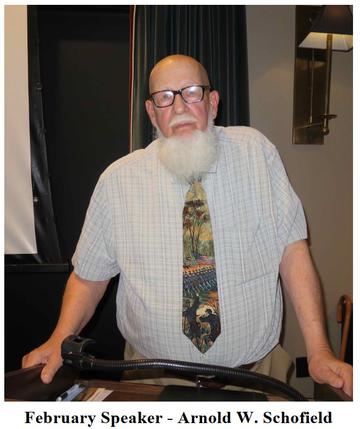February 2022 Meeting

In honor of Black History Month, Round Table member, Arnold W. Schofield gave a program about the First Kansas Colored Volunteer Infantry Regiment.
The First Kansas Colored was the first Black regiment organized in a northern state, the fourth Black regiment to be mustered into federal service, and the first such unit to enter combat in the Civil War. Composed primarily of former slaves, the First Kansas Colored regiment saw major combat in Missouri, Arkansas, and the Indian Territory (Oklahoma).
Arnold handed out copies of brochures about the Fort Scott National Historic Site and the First Kansas Colored Volunteer Infantry Regiment. The following is a summary of Arnold's presentation:
-
Arnold said he authored the brochure titled: "First to Serve" about the First Kansas Colored. He was also asked to review the movie "Glory" for Southwest Missouri State University in Joplin MO. Arnold said "Glory" is one of the best Civil War movies he has seen.
-
The First Kansas Colored was the first Black regiment from a northern state. 180,000 African-Americans served in the Civil War. Recruiting started in the spring and summer of 1862. General David Hunter commanded troops off of the coast of North Carolina. He recruited and armed Black troops. However, Hunter was not authorized to raise this regiment.
-
General Benjamin Butler recruited three regiments of Louisiana Native Home Guards and an artillery unit in May of 1862.
-
Brigadier General James H. Lane ("The Grim Reaper") raised the first Black regiment in the north. The second Confiscation Act, passed July 17, 1862, allowed African-Americans to serve in the Union Army. The governor of Kansas, Charles Robinson, did not like Lane and made him recruiting commander. Lane raised three regiments: two white regiments and the First Kansas Colored. There were two recruiting depots: Mound City and Fort Leavenworth. Any noncommissioned officer (NCO) had to pass a written and an oral test. The governor of Kansas signed the commissions.
-
General James Blunt said to go ahead and recruit Blacks. At night, Union Army recruiters would contact Black churches in Missouri and ask if they knew of anyone that was interested in joining the Union Army.
-
Arnold told us stories about several members of the First Kansas Colored including Colonel James M. Williams, Captain Luther Thrasher, Captain William D. Matthews, Captain Ethan Earle, First Sergeant Clement Johnson, and Private Moses Holt.
-
Some of the soldiers were arrested in Leavenworth City for disturbing the peace. Colonel Williams went to the town and got the soldiers back. In October of 1862, the troops left Fort Leavenworth and went to Fort Lincoln, located near Fort Scott. Major Henning in command at Fort Scott had the First Kansas Colored conduct a search and destroy mission involving a Confederate guerrilla camp near Butler MO. The Battle of Island Mound was fought on October 28, 1862. This was the first time African-American troops saw combat in the Civil War and they defeated the Confederate guerrillas.
-
The First Kansas went into winter quarters at Fort Scott from November 1861 to May of 1862. Colonel Williams established schools and an education fund. He also constructed a telegraph line to Fort Leavenworth. On January 1, 1863, the Emancipation Proclamation was issued. The First Kansas was mustered into the U.S. Army at Fort Scott on January 13, 1863. Company D had Black officers. Captain William D. Matthews was given command of that Company.
-
On May 18, 1863, a foraging party of the First Kansas Colored from Baxter Springs KS stopped to forage for com near Sherwood MO. The First Kansas Colored troops were attacked by Confederate guerrillas at the Reeder Farm. Eight African-American and three white soldiers were killed. The soldiers were massacred and their bodies were mutilated.
-
On July 17, 1863 at Honey Springs, Indian Territory, the First Kansas had a rainbow coalition of whites, Blacks, and Indians. This was a Union victory. The Texas cavalry was mauled.
-
On April 18, 1864 the Battle of Poison Spring, Arkansas took place. The rear guard of a supply train was attacked by a Texas regiment. Again, the First Kansas Colored bodies were mutilated. At the Battle of Jenkins Ferry, the 2nd Kansas Colored regiment was there. They remembered what had happened at Poison Spring.
-
The First Kansas Colored was mustered out in October of 1865. They incurred the most casualties of any Kansas regiment: Five officers and 173 enlisted men killed in action; one officer and 165 enlisted men died from disease. They suffered 360 casualties out of a total of 1,500 who served.
-
The First Kansas Colored Infantry Regiment achieved an excellent combat record during the Civil War, as well as performing garrison, engineer, and escort duties. Colonel James Williams said on April 24, 1864: "The officers and men all evinced the most heroic spirit, and those that fell died the death of a true soldier."
-
At Fort Scott National Cemetery, there is a monument to the First Kansas Colored Volunteer Infantry.
|
| |